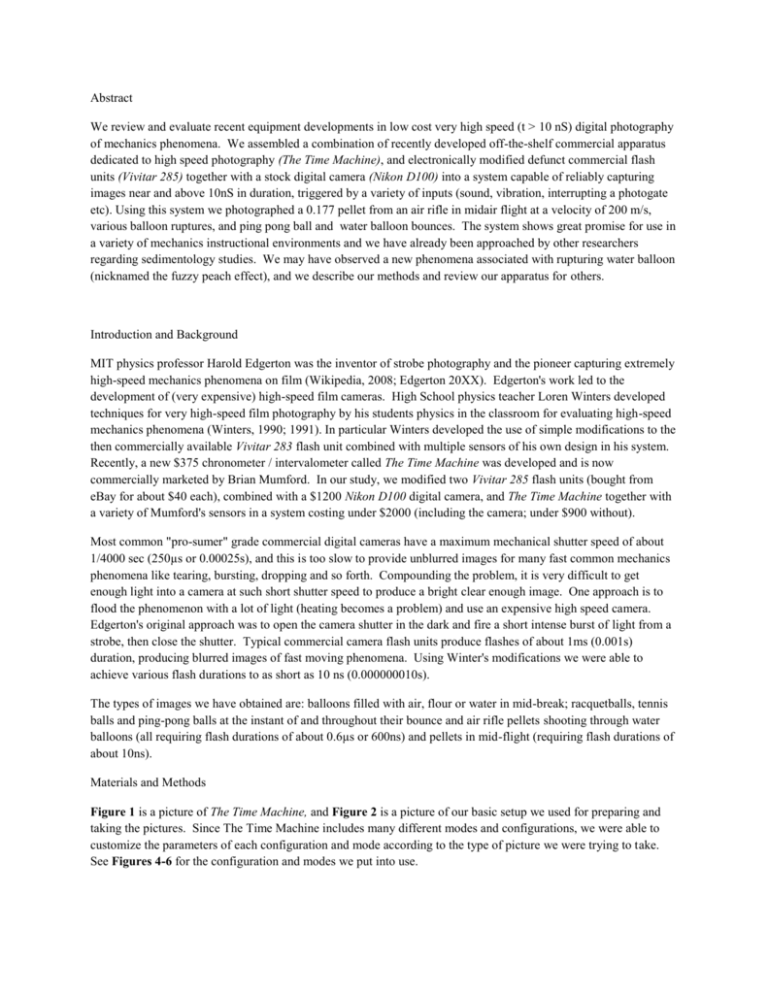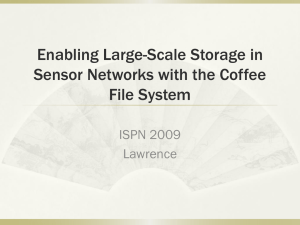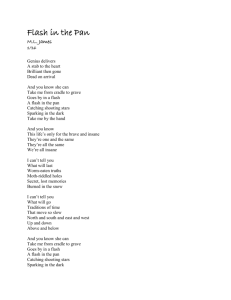Abstract - Physics
advertisement

Abstract We review and evaluate recent equipment developments in low cost very high speed (t > 10 nS) digital photography of mechanics phenomena. We assembled a combination of recently developed off-the-shelf commercial apparatus dedicated to high speed photography (The Time Machine), and electronically modified defunct commercial flash units (Vivitar 285) together with a stock digital camera (Nikon D100) into a system capable of reliably capturing images near and above 10nS in duration, triggered by a variety of inputs (sound, vibration, interrupting a photogate etc). Using this system we photographed a 0.177 pellet from an air rifle in midair flight at a velocity of 200 m/s, various balloon ruptures, and ping pong ball and water balloon bounces. The system shows great promise for use in a variety of mechanics instructional environments and we have already been approached by other researchers regarding sedimentology studies. We may have observed a new phenomena associated with rupturing water balloon (nicknamed the fuzzy peach effect), and we describe our methods and review our apparatus for others. Introduction and Background MIT physics professor Harold Edgerton was the inventor of strobe photography and the pioneer capturing extremely high-speed mechanics phenomena on film (Wikipedia, 2008; Edgerton 20XX). Edgerton's work led to the development of (very expensive) high-speed film cameras. High School physics teacher Loren Winters developed techniques for very high-speed film photography by his students physics in the classroom for evaluating high-speed mechanics phenomena (Winters, 1990; 1991). In particular Winters developed the use of simple modifications to the then commercially available Vivitar 283 flash unit combined with multiple sensors of his own design in his system. Recently, a new $375 chronometer / intervalometer called The Time Machine was developed and is now commercially marketed by Brian Mumford. In our study, we modified two Vivitar 285 flash units (bought from eBay for about $40 each), combined with a $1200 Nikon D100 digital camera, and The Time Machine together with a variety of Mumford's sensors in a system costing under $2000 (including the camera; under $900 without). Most common "pro-sumer" grade commercial digital cameras have a maximum mechanical shutter speed of about 1/4000 sec (250µs or 0.00025s), and this is too slow to provide unblurred images for many fast common mechanics phenomena like tearing, bursting, dropping and so forth. Compounding the problem, it is very difficult to get enough light into a camera at such short shutter speed to produce a bright clear enough image. One approach is to flood the phenomenon with a lot of light (heating becomes a problem) and use an expensive high speed camera. Edgerton's original approach was to open the camera shutter in the dark and fire a short intense burst of light from a strobe, then close the shutter. Typical commercial camera flash units produce flashes of about 1ms (0.001s) duration, producing blurred images of fast moving phenomena. Using Winter's modifications we were able to achieve various flash durations to as short as 10 ns (0.000000010s). The types of images we have obtained are: balloons filled with air, flour or water in mid-break; racquetballs, tennis balls and ping-pong balls at the instant of and throughout their bounce and air rifle pellets shooting through water balloons (all requiring flash durations of about 0.6µs or 600ns) and pellets in mid-flight (requiring flash durations of about 10ns). Materials and Methods Figure 1 is a picture of The Time Machine, and Figure 2 is a picture of our basic setup we used for preparing and taking the pictures. Since The Time Machine includes many different modes and configurations, we were able to customize the parameters of each configuration and mode according to the type of picture we were trying to take. See Figures 4-6 for the configuration and modes we put into use. Time Machine configured to trigger the flash, and manually opening the shutter of the camera (the shutter speed was set to 3 seconds) while we executed the event, which was triggered by a sensor. The pictures were taken in complete darkness. The two sensors we employed during our study were the microphone sensor and the ballistic sensor. The microphone sensor is a microphone that responds to loud, sharp sounds (the sensitivity can be adjusted on The Time Machine). The ballistic sensor is comprised of two photogate sensors spaced four inches apart, and two infrared LEDs directly across from the photogate sensors, all in a tube, and connected to The Time Machine. When a projectile (a pellet in this case; see Figure 3) crosses the sensors, The Time Machine calculates the amount of time it took for the projectile to complete the four inches, then calculates and displays the velocity of the projectile. Using this measurement, The Time Machine can fire the flash of the electronic flash unit (or close the shutter of the camera, depending on the set configuration) at a distance set by the user (in 4 inch increments). Since common high-speed events can occur on the order of microseconds, and the average external flash unit achieves an average flash duration of 1ms, a quenching circuit was needed to shorten the duration of the flash. The need for a short flash results from the exposure time of photographs. The light sensor on the Vivitar 285 flash unit (and any other electronic flash unit) detects the amount of light being let off by the flash unit and, according to the amount of light needed for an exposure, will set a time for the flash to be shut off, using a variable resistor; the higher the resistance, the longer it will take for the flash to be shut off. Since we are trying to take pictures of highspeed events, it is necessary for the length of the flash to be as short as possible without forfeiting too much light intensity (as flash duration decreases, light intensity decreases). It is possible to control the flash duration of the Vivitar 285 manually, by removing the light detector, and placing a resistor in two of the vacant holes 4 (see Figure 2). Figures 8-10 are three tests using different resistances in the Vivitar 285. Results After trying different adjustments of distances, flash angles and intensities (amongst other modifications), we were able to acquire several good photographs of high-speed phenomena. Having determined the appropriate settings for each event, only slight modifications were needed to touch up the photos. The first pictures we were able to attain were of balloons being broken open. The microphone sensor used with the Time Machine on flash configuration and bulb-flash mode gave satisfying results, and only needed modifications in flash intensity to achieve a crisp picture (see Figures 9 and 15). The same settings were used for breaking balloons filled with flour (Figure 16) and breaking water balloons (Figure 13) with superior results. Figure 12 is a series of different instances of dropping a water balloon, with different set delays of the flash to be triggered to take the picture after the microphone sensor sensed the balloon hitting the table. Figure 18 is a multiple-exposure shot of a ping-pong ball having been slid off of a ramp; flash duration and object drop angle and height were all that were needed to achieve a decent 10-exposure photo of a bouncing ping-pong ball. Going with the theme of dropping objects, we dropped a tennis ball to observe the flattening of the ball as it hits the table, which can be examined in Figure 17. The ballistic sensor was used to produce photographs of shot pellets in mid-flight (Figure 14), with slight changes in flash intensity being the only modification. Figure 11, a photograph of a pellet being shot through a water balloon, was produced using the ballistic sensor and the light modifications used when breaking water balloons. Discussion Having obtained decent photographs of relatively high-speed phenomena, we performed some calculations to determine and confirm the speeds we believed we were achieving. The ballistic sensor measured that the pellet being shot through it was traveling 649 ft/s across the four inches. Using LoggerPro, we took data regarding the amount of time separating the firing of the pellet and the landing of the pellet in the backstop with the use of a Vernier microphone, which detected the distinct sounds of the hammer in the gun striking the pellet, and the pellet hitting the plywood of the backstop. See Figure 19 for the placement of the microphone, and Figure 20 for relative distance from the gun to the backstop. Below are some calculations made on the subject of the pellet’s kinematics. In order to calculate the flash durations that we were achieving (after having used different valued quenching circuits in absence of the light detector in the Vivitar 285), we obtained a photo-detector and constructed a circuit meant to run the photo-detector. We then connected the circuit to an oscilloscope, and collected data while flashing the Vivitar 285 into the phototransistor (see Figure 21). The most common resistances we used were 4.7kΩ (for balloons) and 628Ω (for pellets), so we collected data for several executions using these resistances. We were able to obtain consistent data, and determined that: using the 4.7kΩ resistor, the flash duration was about 60ns (or 0.6µs); and, using the 628Ω resistor, the flash duration was less than 10ns. A website containing the information here as well as other projects done during our study has been under construction, and can be viewed for more information. 5 References 1 Mumford, B. The Time Machine. Retrieved June 2, 2008, from The Time Machine Camera Controller/ Intervalometer Web site: http://www.bmumford.com/photo/camctlr.html 2 Winters, L.M. (1990 May). High-speed flash photography with sound triggers. The Journal of the Acoustical Society of America , 87, Retrieved August 7, 2008, from http://scitation.aip.org/getabs/servlet/GetabsServlet?prog=normal&id=JASMAN0000870000S10 00S33000001&idtype=cvips&gifs=yes 3 Winters, L.M> (1991 September). High-speed photography with computer control. The Physics Teacher, 29, Retrieved August 7, 2008, from http://scitation.aip.org/getabs/servlet/GetabsServlet?prog=normal&id=PHTEAH000029000006000356000 001&idtype=cvips&gifs=yes 4 Document by Loren Winters sent by Brian Mumford (have yet to obtain proper reference). 5 Nennstiel, R. (2005, March 13). How do bullets fly?. Retrieved May 26, 2008, from How do bullets fly? http://www.nennstiel-ruprecht.de/bullfly/index.htm WE NEED two Egerton refs here from Wikipedia and his Stopping Time book. Website: 6 http://physicsed.buffalostate.edu/EURP08





